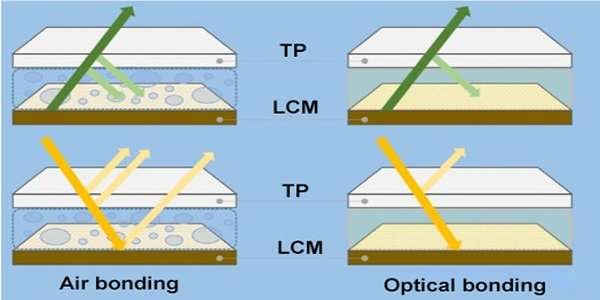To produce a touch display, it is a process to bond the touch panel (TP) to the LCD module (LCM).
In light of the adhesive method and material, there are two major bonding technologies, air bonding and optical bonding.
Air bonding
Air bonding is the adhesive technology by using adhesive tape (normally double-sided adhesive) to bond touch panel with LCM along the sides of the outer frame. Hence, it is an air gap inside. That is why people also call the bonding, frame gluing.
Advantages
- Mature process and stable yield
- Simple process and low cost
- Simple rework process
Disadvantages
- The air gap between TP and LCM increases the reflection and lowers the transmittance of light, therefore degrading the display performance.
- The air gap gives room for dirt and dust particles to enter.
- The structure is relatively thick
Optical bonding
Optical bonding is the adhesive technology by applying optical adhesive fully on and between touch panel with LCM, which eliminates the air gap and makes the screen thinner.
Optically Clear Adhesive (OCA) and Optical Clear Resin (OCR) are typical optical adhesive. They are transparent and allow light transmittance more than 90%.
Advantages of removing the air layer:
- Low light reflection, high transmittance, maintain quality display
- It reduces the loss of light and saves power to reach the same brightness
- Good touch performance
- No room for dirt and dust particles after assembly
Disadvantages
- Process is relatively complex and low yield, which increases the cost.
- Once it has dirt or bubbles inside, the entire screen needs to be replaced.
How to choose between air bonding and optical bonding?
Comparison between air bonding and optical bonding
Recap above pros and cons of both bonding technologies:
| Air Bonding | Optical Bonding | |
|---|---|---|
| Light Reflection | High | Low |
| Light Transmittance | Average | Higher |
| Moisture Prevention | Average | Excellent |
| Dust Prevention | Average | Excellent |
| Display Effect | Average | Good |
| Structural Strength | Average | Strong |
| Production Yield | about 99% | about 90% |
| Cost | Average | Higher |

Tips to make a selection
In light of choosing the applicable bonding method for your touch display, we could share our project experience for your consideration:
- From the display and touch performance, optical bonding is better than air bonding regardless of the cost.
- However, air bonding is a feasible option given its mature technology.
- In our project experience, most of the projects using capacitive touchscreen choose the optical bonding, while projects using resistive touch panels, some of them have specific requests to apply the optical bonding.
Currently, both technologies are common, the selection depends on the specific requirements and budget of the project.
We can provide both bonding technologies for touch display as per your request, feel free to contact us for more information.

